Bibi Maryam Mosque
Bibi Maryam Mosque (Bengali: বিবি মরিয়ম মসজিদ, Arabic: مسجد بيبي مريم) is a three-domed mosque located in the Killarpul neighbourhood of Narayanganj in Bangladesh. It is an example of Mughal architecture though renovated over time, and is in close proximity to the mausoleum of Bibi Maryam. The place of worship is also known as Killarpul Shahi Jame Mosque (Bengali: কিল্লারপুল শাহী জামে মসজিদ). Despite its limited accommodation, the site has been acknowledged as one of the prominent surviving Mughal buildings in the country.
| Bibi Maryam Masjid | |
|---|---|
বিবি মরিয়ম মসজিদ | |
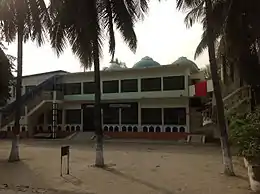 The view of Bibi Maryam Masjid | |
| Religion | |
| Affiliation | Sunni Islam |
| Location | |
| Location | 114 Mukarba Road, Killarpul, Narayanganj, Bangladesh |
| Architecture | |
| Type | Mosque |
| Style | Mughal Architecture |
| Date established | c. 1875 |
| Interior area | 9,980 sq ft (927 m2) |
History
Most historians suggest that Shaista Khan, the Mughal governor of Bengal Subah from 1664 to 1688, built the mosque within a fortified complex in the early 1680s. Presumed to be Bibi Maryam's father, Khan named the site after his daughter's premature demise and also had her tomb built nearby.[1] Historians who have examined the used building materials and applied construction techniques to learn that both were exercised during the age of Nawab Shaista Khan's existence. According to the present mosque authority, only members of Shaista Khan's family and administration formed the Muslim population of present-day Killarpul during its construction which explains the limited accommodation. Even as late as the 1950s, Killarpul's population was almost monopolised by Hindus, with hardly ten Muslims appearing for congregational prayer. This is in stark contrast to today, where hundreds of worshippers appear for any prayer.
Architectural elements and style
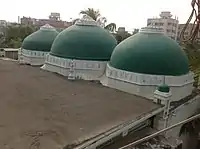
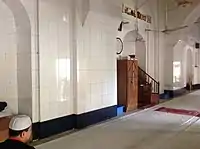
The mosque was originally built as an extremely tall single-storied mosque with a great emphasis on the vertical qualities. Three mihrabs are located in the western wall stood from the base of the ground floor to one-third the height of the first floor. These mihrabs have been compressed in width and shortened in height; otherwise, they would structurally relate to the three domes to portray one of the site's prime architectural essences. The remains of the authentic mihrabs are present in the first floor and rise as much as one-third of its height in the western wall. In 2001 the first floor was inserted directly in the mosque, which all but jeopardised the structural beauty defined by the relationship between the domes and the mihrabs. After the construction of the first floor, the beauty of the domes and mihrabs remain undecipherable where the former's view is completely obstructed by the roof of the first floor and the latter's size has been greatly altered. The architecture of the Bibi Maryam Mosque is defined by a combination of embellishments and proportional adjustment among elements such as arches, domes, mihrabs etc., all which have been used in a series of three members. In such elements the middle one is much larger and more emphasised than those that flank it. For instance the interior space was roofed by the three domes where the central dome is much larger than the subsidiary ones located at its either side. The use of three domes in such manner for a mosque is a very distinctive feature of Mughal style. There is a minaret situated at the eastern corner of the main building which was built during the 1971 Liberation War and has lost its authentic features due to later repairs which completely modernised it. The interior hall has simple lateral arches, but the side domes have been reduced in size by adjusting the thickness of the side walls. The three domes are embellished with basal leaf imitations and the walls are fortified. The embellishment of the outer surfaces or walls which in the contemporary typical Mughal mosques were plaques and floral and geometric motifs are also untraceable. A veranda has been later added alongside the first floor due the eastern facade of the mosque to accommodate more number of worshipers which has marred the beauty of the mosque. Originally there was an open plaza that adjoined the eastern facade adding to its beauty and measured 50 feet by 20 feet. The mosque even though is rectangular in shape but looked more of a square where the 50 feet width is marginally bigger than its 45 feet breadth.
Relationship with the complex
The historical records clarify that the fortified complex existed prior to both the simultaneously constructed masjid and shrine it houses. This complex is entirely fortified with 4-foot-wide and 12-foot-high boundary walls where the prime building is the Bibi Maryam Shrine. The masjid faces the shrine located exactly opposite to it and its central axis is aligned with that of the shrine.
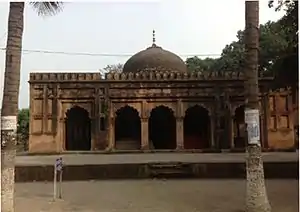
The masjid was built simultaneously with the shrine to fulfill the need for congregational prayer and secondly to complement the significance of the shrine by availing the scope for worshipers to pray for the deceased Bibi Maryam's salvation. This shrine leads to a subsidiary shrine and located at the western end of the Masjid is a secret passage by which Nawab Shaista Khan's soldiers could access the Hajiganj Fort. The rectangle-shaped Bibi Maryam shrine is accessible from all directions with five arches on all its facades and is topped by a dome. Unlike the Bibi Maryam Masjid the shrine has retained all its architectural qualities despite undergoing conservation numerous times.
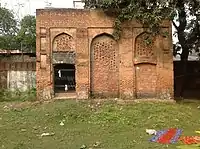
It reflects the age during which it was built. After 1971 Liberation war substantial area of the Bibi Maryam complex has been consumed by Bibi Maryam Girls Primary School, for which a large part of the eastern and southern fortifications had to be demolished. The shrines and the masjid are located on elevated surfaces. Another building is located adjoining the fortified walls at the southern direction, which was the dwelling of the Nawab's soldiers who guarded the complex. The main shrine is a monochromatic structure plastered with light-brown surfaces and adorned with recessed rectangular panels. The parapet of the shrine is decorated in the same style as the top of the fortified boundary walls. It is presented with a set of three arches in the middle flanked at the right and left sides by a single arch of identical size and features. The shrine has been built on an elevated platform which measures three feet high and is accessed by a recessed staircase whose appearance is absolutely ruined.
Mughal embellishments of the Masjid
Although the plaques and motifs which adorned the Bibi Maryam Masjid disappeared long ago, still the themes can be deduced by analysing those still preserved in the shrine and other buildings of the complex. Some of the embellishments were produced as patterns of voids and minute angular shapes by piercing the walls directly. The other elements are basically projected or recessed rectangular plaques and floral and geometric motifs. The latter types also enhance the incident natural lighting in buildings both for comfort and aesthetic purposes. This strategy has been commonly employed in Islamic architecture and is strongly featured in the shrine and subsidiary shrine.
But, unlike the shrine, it has transformed radically under the different conservation and construction phases. The Masjid stands with completely deprivation of its true architectural significance. Several books have been written to unravel its wonders albeit with limited hypothetical conclusions and are oriented more towards sensitivity of its values. The scarcity of the information is attributed to its faint documentation in the context of history and irresponsibility of the government in treating it as a national heritage. However, it is not absolutely dilapidated, since a lot can be traced from the surviving elements such as domes, arches and load-bearing walls that defined the space in its inception.
References
- Khan, Muazzam Hussain (2012). "Bibi Mariam Mosque". In Islam, Sirajul; Miah, Sajahan; Khanam, Mahfuza; Ahmed, Sabbir (eds.). Banglapedia: the National Encyclopedia of Bangladesh (Online ed.). Dhaka, Bangladesh: Banglapedia Trust, Asiatic Society of Bangladesh. ISBN 984-32-0576-6. OCLC 52727562. Retrieved 30 January 2021.
- Zakaria, A.K.M (2004). Bangladesher Prachin Kirti. Dhaka: University Press Limited. (pp. 161–162).
- Bangladesh Asiatec Society (2007). Banglapedia. Dhaka: Bangladesh Jatiyo Gyankosh. (pp . 241–242).
- Mamoon. M (2008) Dhaka Sritir Bisritir Nagari. Ananya. (pp. 180).
_002.jpg.webp)